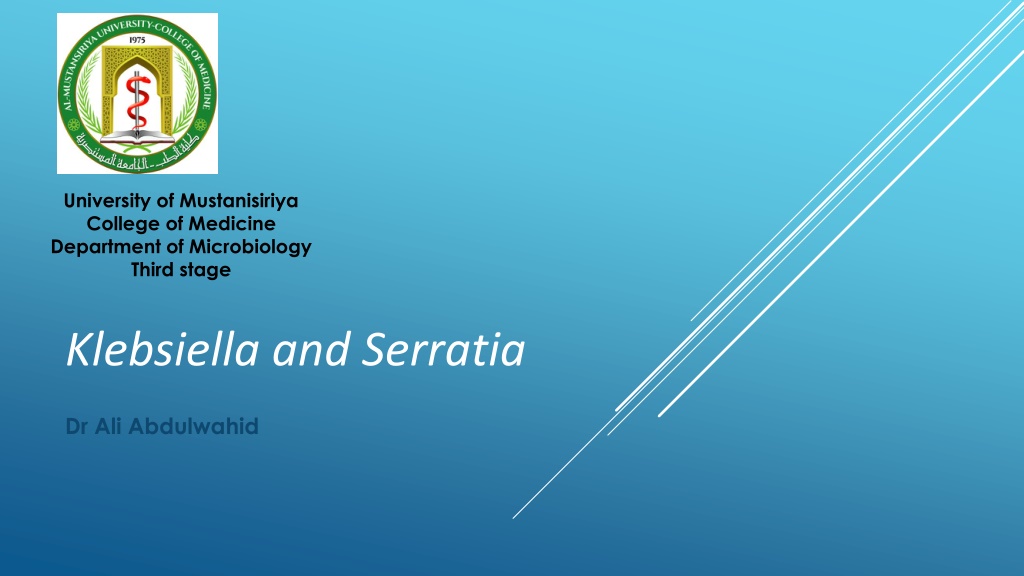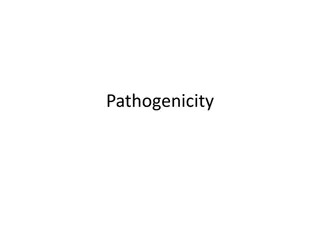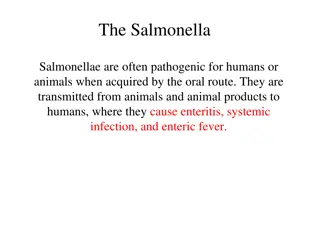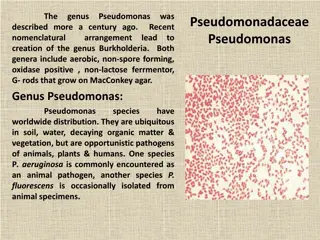Klebsiella Species: Characteristics and Pathogenicity
Klebsiella species, such as K. pneumoniae and K. oxytoca, are gram-negative bacilli commonly found in the microbiota of the intestines, nasopharynx, and feces. They exhibit distinct characteristics like pink mucoid colonies on MacConkey's agar and are known to cause both community-acquired and hospital-acquired pneumonia. K. pneumoniae has various subspecies with specific surface antigens, making them identifiable in clinical settings.
Download Presentation

Please find below an Image/Link to download the presentation.
The content on the website is provided AS IS for your information and personal use only. It may not be sold, licensed, or shared on other websites without obtaining consent from the author. Download presentation by click this link. If you encounter any issues during the download, it is possible that the publisher has removed the file from their server.
E N D
Presentation Transcript
University of Mustanisiriya College of Medicine Department of Microbiology Third stage Klebsiella and Serratia Dr Ali Abdulwahid
Klebsiella spp. Overview Klebsiella species are gram-negative, nonsporing bacilli Grow on ordinary media, exhibit pink mucoid colonies on MacConkey s agar, produce large polysaccharide capsules lack of motility, and they usually give positive test results for lysine decarboxylase and citrate Natural habitat: Klebsiella pneumonia is a member of the large intestine microbiota it also presents in the nasopharynx and feces of about 5% of normal individuals. It can also be found on the soil , water and on plant
The most commonly isolated species are K. pneumoniae and K. oxytoca Although K. pneumoniae are more frequently isolated than K. oxytoca by clinical labs, both of the species are important pathogen to human , which known to cause community as well as hospital acquired pneumonia. patients with K. pneumoniainfection frequently have predisposing conditions such as advanced age, chronic respiratory disease, diabetes, or alcoholism. The organism is also carried in the respiratory tract of about 5 % of healthy people, who are prone to pneumonia if host defences are lowered Other important species : K. granulomatis , causing a chronic genital ulcerative disease
K. pneumoniae K. pneumoniae There are 4 subspecies are classified under the species K. pneumoniae : K. pneumoniae subsp. aerogenes. K. pneumoniae subsp. ozaenae, K. pneumoniae subsp. pneumoniae, K. pneumoniae subsp. Rhinoscleromatis these four subspecies were previously described as independent species, and then classified under K. pneumoniae as subspecies
General characteristics Surface antigens As members of enteric family, K. pneumoniae and other species have the three surface antigens, which include : O antigen (Somatic antigen) : similar to O antigen of some of E. coli strains (show cross reactivity with their specific antisera ) Flagellar (H) antigen and capsular (K) antigen). The large capsules (consisting of polysaccharides) produced by Klebsiella (K antigens) covering the somatic (O or H) antigens and can be identified by capsular swelling tests with specific antisera. Human infections of the respiratory tract are caused particularly by capsular types 1 and 2 and those of the urinary tract by types 8, 9, 10, and 24.
Morphology Klebesiella pneumoniae colonies on MacConkey agar: the colonies typically appear large, mucoid and red in colour. Klebsiella pneumoniae gram staining: short, plump, gram-negative, rods The source of the picture: https://www.microbiologyinpictures.com/bacteria%20photos/kleb siella%20pneumoniae%20photos/KLPN37.html Sorce of the picture : http://www.bacteriainphotos.com/Klebsiella%20pneumoniae% 20on%20MacConkey.html
Virulence factors As a member of the enteric family, the bacterium share many virulence factors that characterised for enteric bacteria that can lead to infection and antibiotic resistance, include : Lipopolysaccharides: that cover the outer surface of a gram-negative bacteria which act as endotoxin. Fimbriae: allows the organism to attach itself to host cells The polysaccharide capsule: which has an important role in immune evasion. To date, 77 different capsular types have been studied, and those Klebsiella species without a capsule tend to be less virulent. Multidrug resistance factors : acquisition of plasmids that carrying encoding genes for antibiotic resistance factors such as carbapenemase.
Capsule as main virulence factor Capsule as main virulence factor Capsule plays an important role in the pathogenicity of klebsiella pneumoneae It facilitate tissue invasion by enhancing evasion of the bacteria from phagocytosis and protect cells from bactericidal molecules It is a differential feature for the bacterium and used to differentiate them from other species Klebsiella pneumoniae with different staining techniques 1. K. pneumoniae in an India ink 2. K. pneumoniae in a heterologous antiserum 3. K. pneumoniae , in antiserum, revealing a positive Quellung reaction, The colonies of capsulated strains are greyish white and extensively mucous.
Transmission and diseases The bacteria can be spread through person-to-person contact (for example, from patient to patient via the contaminated hands of healthcare personnel, or other persons) Also by hospital devices such as ventilators and intravenous catheters less commonly, by contamination of the environment. They are not spread through the air As it a member of macrobiotia, when it get into other areas of the body, they can cause different opportunistic infections including : wound infection, UTI, sepsis , pneumonia and meningitis. Healthy individual is mostly out of risk , but people who have health problems such as alcoholism, cancer , diabetes , kidney failure, liver disease, lunge disease are at risk to get Klebsiella infection
Transmission and diseases K. pneumoniae It causes a small proportion (~1%) of bacterial pneumonias (mostly immunocompromised people). It can Produce lobar pneumonia with extensive hemorrhagic necrotizing consolidation of the lung, and has distinct clinical feature including : Severity and propensity to affect the upper lobes The production of currant jelly sputum as a result of the associated haemoptysis, and abscess formation It is also ranked among the top 10 bacterial pathogen responsible for hospital acquired infections including septicemia and meningitis It produces urinary tract infection and bacteraemia with focal lesions in debilitated patients.
Recently particular clone of K. pneumoniae has emerged as a cause of community acquired pyogenic liver abscess that is seen mostly among Asian males worldwilde This particular stain with capsular type K1 appear phenotypically hyper-mucoviscous on agar media . Two other Klebsiella subspecies are associated with inflammatory conditions of the upper respiratory tract: o Klebsiella pneumoniae subspecies ozaenae: isolated from the nasal mucosa in ozena o it causes ozena, a fetid, progressive atrophy of mucous membranes o K pneumoniae subspecies rhinoscleromatis: form rhinoscleroma, a destructive granuloma of the nose and pharynx, larynx and even trachea. o Both the diseases are more commonly seem in the tropical regions in the world o It spread by person to person transmission.
Klebsiella granulomatis Causes chronic genital disease granuloma inguinal (thought to be Sexually Transmitted disease) The disease occur periodically in tropical regions in the world including the Caribbean, south America and south- east Asia. The bacteria cannot grow in standard culture in the lab It is visualised in tissue smears or biopsy specimens as pleomorphic bacilli present in in the cytoplasm of machrophage and PMNs stained by Giemza stain.
Lab diagnosis Laboratory Diagnosis Microscope examination: Gram staining, capsule staining, quelling reaction (for capsule detection) Culturing: appropriate specimens can be plated on blood agar, and MacConkey agar (looking for lactose fermenter, large, mucoid and red colonies) The resultant growth can be used for biochemical tests as well as microscopic examination Biochemical reactions. The bacteria ferment glucose, lactose, sucrose, mannitol, with production of acid and gas. urease +, indole - , MR - , VP + and citrate + (IMViC ++). Antibiotic sensitivity test: antibiotic sensitivity should be done (many strains carry plasmids determining multiple drug resistance).
Treatment Antibiotic resistance: genetic studies (multi-locus sequence typing) identified global emergence of two particularly important clones: Sequence type (ST) 16 clone elaborated extended spectrum of beta-lactamase resulting in resistance to broad range of penicillins and cephalosporins, but not carbapenem antibiotic) Other clones (ST 258) a multidrug resistance strain called a carbapenemase producer because it resistant to all beta-lactam antibiotics including the broad spectrum carbapenem agents. Typically , it is resistance to other antimicrobial agent due to acquisition of plasmid that carry multiple resistance genes. In such cases, a microbiology laboratory must run tests to determine which antibiotics will treat the infection.
Treatment In general, Clinical isolates of Klebsiella are resistant to the penicillins ( including to ampicillin, amoxicillin and others) Combination of these drugs with -lactamase inhibitors are usually effective. They are susceptible to cephalosporins, such as cefuroxime and cefotaxime, and to fluoroquinolones. Often sensitive to gentamicin and other aminoglycosides. Pneumonia and other serious infections require vigorous treatment with aminoglycoside or a cephalosporin such as cefotaxime The antibiotic treatments recommended for the infection granuloma ingunale (caused by K. granulomtis ) is azithromycin (1 g orally a week for at least three weeks) , or alternatively treated with ciprofloxacin, doxycycline or trimethoprim-sulphamethoxazole
Serratia Serratia spp. spp. Serratia species are common opportunistic pathogens as well as colonizer in hospitalized patients They typically transmitted from person to person (Nosocomial transmission may occur by hand contact from hospital personnel and other patients). Fomites may also spread Serratia It can also transmitted via medical devices, intravenous fluids and indwelling catheters . In children, the GTI is often servs as reservoirs for infection
General characteristic Gram negative-rod shaped bacteria A member of enteric family Free living saprophyte (widely spread in the environment including water soil and plants) not a common component of the human flora facultative anaerobes Motile Late lactose fermenter Produces DNase, lipase, and gelatinase. Usually give positive Voges-Proskauer reaction
Serratia marcescens Serratia marcescens Serratia marcescens is the medically important species Itis a common opportunistic pathogen in hospitalized patients and causing nosocomial infections in immunocompromised people. Transmit from person to person , and also via medical devices, intravenous fluids and catheters. produce characteristic red pigment (prodigiosin) The pigment gives growth benefits for the bacteria in the environment It also Gives protection from physical and chemical stress and growth advantage at ambient temperatures
Only about 10% of clinical isolates of S. marcescens produce the pigment It can be indicator for the environmental origin of the strain Serratia marcescens colonies on agar plate (produce prodigiosin pigment)
Infections The most common site of infection include the urinary tract The bacteria can also cause: Pneumonia Bacteremia Wound infections Bone and soft tissue infections Endocarditis (mostly in intravenous drug users)
Lab diagnosis Specimens depends on the localization of the disease process , and it can involve : Blood Urine Pus Sputum or other material Smears: looking for gram negative rods, and as it a member of the enterobacteriaceae, it can not be differentiated from other members as they are resemble each other in their morphology Culturing : Mackonkey : late lactose fermenter (can produce a negative reaction) Blood agar : non heamolytic production of prodigiosin pigment (mostly for environmental strains) Biochemical tests : IMViC : --++ , Urease ( ) , Oxidase -ev.
Treatment Treatment of infections caused by Serratia marcescens is often difficult due to resistance to multiple antibiotics. The bacteria showed resistance to penicillin, ampicillin and first generation cephalosporins (because it harbors an inducible chromosomal AmpC beta- lactamase. Resistance to fluoroquinolones (due to gyrA mutations) Resistance to trimethoprim-sulfamethoxazole has also been described. Due to the variability in resistance to antibiotics, no empiric guidelines are available for treatment of infection caused by Serratia marcescens
References 1. Reidle, S., Morse, S. A., Meitzner, T., and Miller, S. 2019. Jawetz, Melnick & Adelberg s Medical Microbiology , Twenty-Eight Edition. The McGraw-Hill education, Inc. USA 2. Websites : 1. Microbiology in picture (https://www.microbiologyinpictures.com) 2. Bacteria in photos (http://www.bacteriainphotos.com) 3. Microbe online (https://microbeonline.com)
Thank You For Your Attention

























